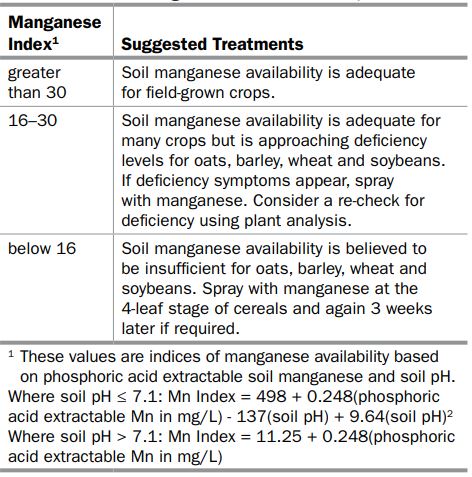Manganese deficiency in dry edible beans has been diagnosed occasionally in Ontario. This problem is more likely to occur on muck soils or very sandy soils. Plants with manganese deficiency have pale green-to-white upper leaves. The veins of affected leaves will remain green. The pattern can appear similar to iron deficiency, but manganese deficiency occurs more generally over the entire plant whereas iron deficiency appears on new growth.
In general, beans will give a profitable response to manganese in the parts of the field where manganese deficiency is obvious. There is no benefit to applying manganese to beans that are not showing deficiency symptoms.
Preventing and Correcting Manganese Deficiency
The crops most susceptible to manganese deficiency are soybeans, dry edible beans and cereals. Correct the deficiency as soon as it is detected by spraying the foliage with 2 kg/ha (1.8 lb/acre) of actual manganese from manganese sulphate (8 kg/ha (7.1 lb/acre) of manganese sulphate) in 200 L (44 gal) of water. Use of a “spreader-sticker” is recommended. Use a spray grade manganese product to prevent nozzle plugging.
In good growing conditions, the affected leaves should green up in 4–5 days. Chelated manganese products are equally effective if applying the same amount of manganese, but the cost is significantly higher than manganese sulphate. Low rates of chelated manganese are not effective in correcting a deficiency.
Manganese is less available at high soil pH, so it is important not to add more lime than is needed to correct soil acidity. The oxidized form of Mn is less available than the reduced form, which is why sometimes symptoms appear in areas with greater aeration and less compaction.
Sampling for Manganese
OMAFRA-accredited soil tests are available for manganese. Manganese is reported as an index to account for both the amount of nutrient extracted from the soil and the soil pH. Soil pH has a huge impact on the amount of manganese that is available to plants. With manganese, plant analysis, visual symptoms and the soil test are all useful.
Table 1. Manganese soil test interpretation
